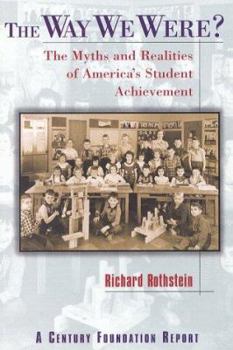The Way We Were?: The Myths and Realities of America's Student Achievement
According to conventional wisdom, American public schools have suffered a terrible decline and are in need of dramatic reform. Today's high school students, it is alleged, display an ignorance of... This description may be from another edition of this product.
Format:Paperback
Language:English
ISBN:087078417X
ISBN13:9780870784170
Release Date:September 1998
Publisher:Century Foundation Press
Length:140 Pages
Weight:0.60 lbs.
Dimensions:0.4" x 6.0" x 8.9"
Related Subjects
Administration Assessment Education Education & Reference Education Theory Reform & PolicyCustomer Reviews
2 ratings
The Way It Is
Published by Thriftbooks.com User , 22 years ago
In very smooth and readable prose, free of "paradigm-speak," Rothstein examines the much touted crisis of decaying intellects of American public school students.Since most chicken littles of the academic crisis cite declining SAT scores, Rothstein begins with an examination of exactly what the SAT is supposed to measure, and more importantly, who takes the SAT. Since SAT scores reflect the achievement of a self-selected group, because the SAT is not required, these scores aren't of much use in demonstrating the abilities of an entire senior class (not to mention the fact that juniors and seniors take it together, along with some sophomores as well). I learned the surprising fact that until 1994, yearly scores were still compared (with some adjustment, but nonetheless....) to a group of young men who had all gone to private schools, and who took the test in 1941.Rothstein includes information about declining dropout rates since the 1930's, and how this effects achievement scores of a senior class; he looks at more legitimate means of comparing students, such as the Iowa Test of Basic Skills. He also looks at the correlation between income and SAT scores, and documents the fact that more students from lower income families have been taking the test in recent decades.In the last chapters, Rothstein examines some of the other issues facing schools, such as bi-lingual education, and phonics vs. whole word methods of reading instruction.Anyone in education, and anyone concerned about national student achievement should read this book.
Excellent objective analysis of present and past test scores
Published by Thriftbooks.com User , 25 years ago
In 114 pages of very readable writing, the author sheds light on what test scores mean, and don't mean, from past and present. The difficulty of comparing SAT scores from the 1940's, to the scores in recent years, is more than just difficult. It's impossible, and for a number of reasons that he explains well -- only one of which is that the test is voluntary. Really, what he writes is fascinating. For example, SAT scores are used to judge the teaching effectiveness of different states. Iowa and North Dakota score very high. But in Iowa, for example, only the top 3% of their students take that test! In NJ, on the other hand, 74% of the students recently took the test. Would you not expect the results to be different -- lower -- if 74% of the kids take the test rather than the top 3%? Sure.The problem is that it's exactly those tests -- and others -- which are used to tell us how we've gotten worse in our school systems.In 1941 -- the first year of the SAT -- approximately 1% of all high school students took the SAT. Accurate demographic data don't exist, but the test was taken, for the most part, by the kids from wealthy families. Today, the percentage of kids taking the test is much greater. And thus the demographics are vastly different. Yet we draw mistaken conclusions from test results then, and now, that are simply statistically impossible to make.Very interesting book. Gives a much-needed historical perspective. The author's conclusion -- that schools are actually doing a better job today than in years past -- is quite well-supported.Final note: the average IQ in our country went up 15 points -- a huge gain -- from 1932 to 1978. (No analysis done since then that the author noted.) Is this the sign of a system in disarray? Doesn't seem so. The author is quick to point out that his analysis isn't meant to say that no improvements can, or need be, made in our schools. But perhaps we're seeing "crisis" about the wrong things. And putting money into the wrong things. He encourages us to make objective analysis, and to understand what we can conclude -- and what we cannot. Excellent. Read it.





